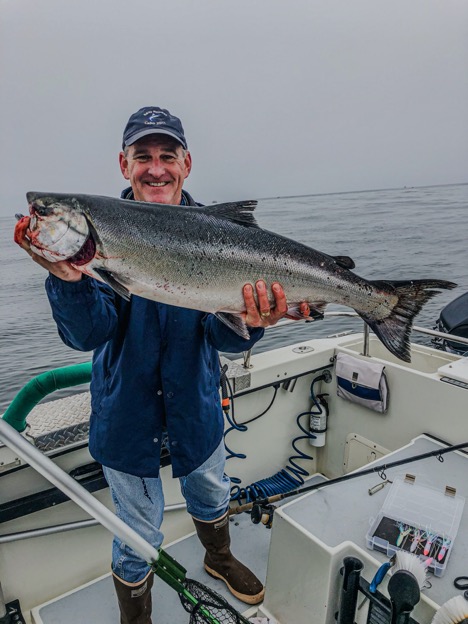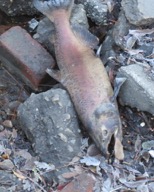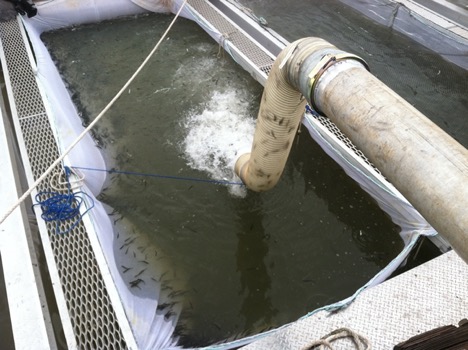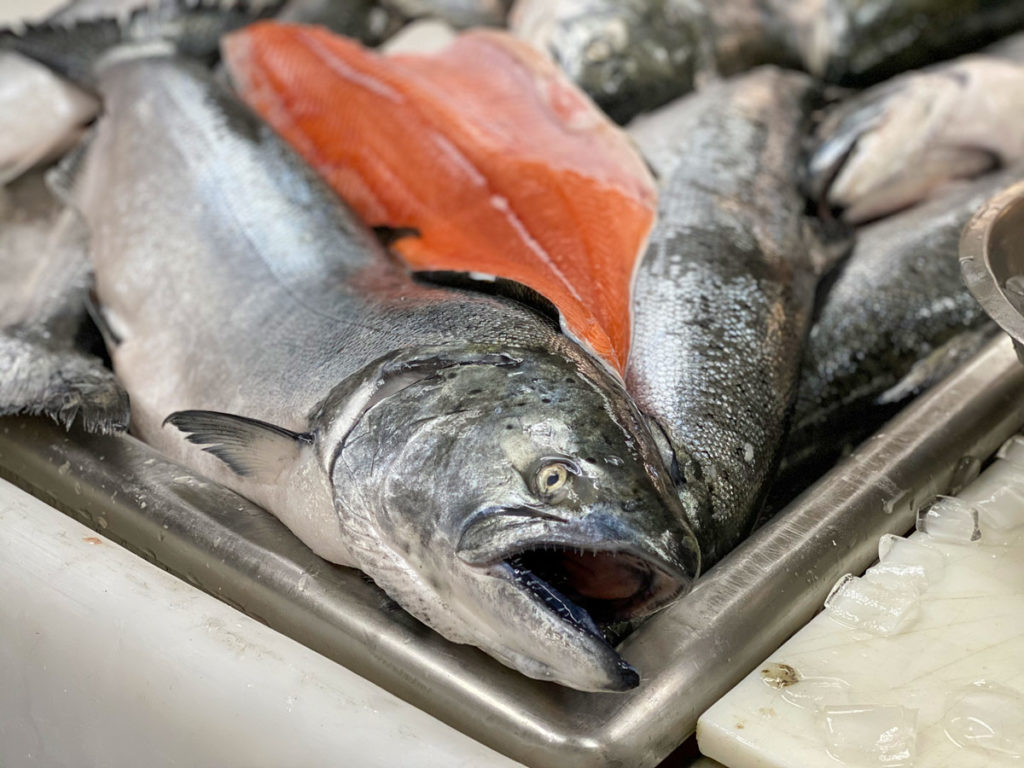Salmon season underway

Readers of this newsletter will likely know more than we do by the time you receive this but here’s a snapshot of the season to date.
After being delayed for almost a month, the sport ocean salmon seasons opened May 1. The commercial season opened then too with decent early catches in Monterey Bay out of Santa Cruz, Moss Landing, and Monterey. After a week and a half, and some good size fish caught, that bite seemed to taper off.
Low prices initially paid to the commercial fishermen bounced up by the second full week of the commercial season as catches ebbed. Enthusiastic buyers seemed to pop up everywhere and the fresh salmon was welcomed by many customers dying to get some of the best salmon in the world.
Although a few spots of salmon have been encountered by the sport fishing fleet off the San Mateo, San Francisco, Marin and even Mendocino countes’ coast, no real school had been found, outside of that initial Monterey Bay group, as of this writing. Seasoned hands say this isn’t unusual for this time of year and hopes are high for better fishing in the coming weeks and months.
The charter boat fleet has remained tied up due to covid concerns but we’ve just gotten word that charter boats out of Berkeley have been cleared to fish. Hopes are high that government agencies will soon give a green light for the rest of the fleet to operate.
Hopes are also high that state and county authorities will soon ease more restrictions on harbor and launch ramp access for the sport anglers.
GSSA wins major court battle to save salmon
On May 11 a federal court ruled that a water diversion and pumping plan run by the federal Bureau of Reclamation, deadly to salmon and other wildlife, must restrict its pumping. The ruling comes in two cases, one brought by GSSA and allied groups and one brought by the state of California. Both seek to overturn excessive water diversions developed under US Interior Secretary David Bernhardt, because of the extreme environmental damage they are causing.
The court directed the federal government to reinstate a restriction on Delta pumping that is more protective of juvenile salmon and steelhead through May 31, when the more protective rule would annually expire. Baby steelhead and salmon are currently migrating through the Delta.
The federal rules being challenged allows boosted water diversions from salmon rivers in northern California and the Delta by 600,000 acre feet per year at a time when the state and multiple scientific agencies have repeatedly documented the need to reduce such diversions and leave more water in the rivers to maintain salmon and other native wildlife.
Last July the National Marine Fisheries Service (NMFS) scientists rejected the new federal pumping and diversion plan and pointed out the harm it would do to salmon and other wildlife. Later, under pressure from the US Department of Interior, NMFS reversed course and reluctantly gave its approval.
The fishing and conservation groups presented evidence to the court that the lax federal water rules illegally ignored established science demonstrating that protected fish populations have been precipitously declining, that federal water project operations have significant, adverse effects on these imperiled populations, and that existing protections need to be increased to avoid further jeopardizing the species. Even though federal fish and wildlife agencies until recently supported the science, under Bernhardt and the Trump administration, they arbitrarily flip flopped, a reversal noted by the court.
GSSA and allies also asked the court to restrict the federal Bureau of Reclamation, the operator of Shasta Dam, from releasing too much cold water from Lake Shasta this spring because it will be needed later in the year to help salmon successfully spawn. The court said it would decide this issue later.
Water districts throughout the state, both those getting water from the federal water project and those getting water from a parallel state water project have backed the federal attack on California’s water and entered the court case to oppose GSSA and allies. They have also attacked Governor Gavin Newsom for allowing the state to go to court to defend salmon and the state’s natural resources.
Although much of the legal arguments revolved around the federal government’s obligation to protect winter and spring run Chinook salmon and steelhead, GSSA sued because those protections also provide benefits to the fall run salmon that supply the ocean and inland fishery.
GSSA also asks State Water Board to intervene to save Sac River salmon spawn

In addition to asking a federal court to stop damaging federal water operations, GSSA is also asking the State Water Resources Control Board for help. GSSA is urging the water board to use its authority to require the feds to leave enough water in Lake Shasta through the summer to supply the cold water returning adult salmon will need in the fall to spawn.

The Bureau admits its Shasta reservoir releases are likely to result in heated river water by late summer that will kill at least 27 to 28 percent of winter run salmon spawn. It will also leave a river too hot to support spawning fall run, the run the salmon industry relies on. In a letter to the State Water Board, GSSA demonstrates more credible calculations show the loss of salmon is likely to be considerably higher than the Bureau admits.
GSSA started warning the public and policy makers last July after the National Marine Fisheries Service scientists first sounded the alarm. Then in August, the California Dept. of Fish and Wildlife sent a letter to the Bureau repeating those warnings which was ignored. Now the Bureau of Reclamation is rushing to divert more of the state’s northern salmon river water to supporters in the dry western San Joaquin Valley and proving those warnings were well placed.
The State Water Board has rarely used its authority to reign in the damaging water practices of the federal government. A crack appeared in March when the State Water Board sent a letter to the Bureau of Reclamation asking it to revive its Shasta reservoir release plans to make them more protective of salmon. The Bureau failed to produce the requested revisions.
Federal water operations in the fall also threaten to dewater salmon redds, or nests, killing even more eggs.
The overheating of the upper Sacramento River, once the strongest salmon spawning grounds in the state, also forces salmon to stray from their natural spawning areas to nearby creeks that sometimes run a few degrees colder. This has happened in the past and is likely to happen again. This typically encourages upper Sacramento fall run salmon to stray into the colder waters of Battle and Clear creeks to spawn. Hatchery managers at the Coleman hatchery on Battle Creek kill excess salmon when this happens.
Some hatchery releases slightly compromised this year

The CA Dept. of Fish and Wildlife had several back to back to back releases at Mare Island near Vallejo this year in conflict with the unwritten two day on, five day off release guideline. As expected, there were reports that striped bass figured things out and were easily caught by anglers in the area. After learning of the planned multi-day releases, GSSA spoke with CDFW and pleaded the case to break up the releases by alternating with another nearby release site. However, the state said they were dealing with staffing and logistical problems due to covid and couldn’t accommodate. A CDFW staffer later told GSSA that subsequent plans to do more multi-day releases were rescheduled after GSSA weighed in with the CDFW higher ups.
A million fish were released from the Feather River hatchery on May 2 and 3 and 600,000 from the Nimbus hatchery on May 5 at the Mare Island site. Another million fish from the Feather River hatchery were released May 7, 8 and 9 at the same location. In two years we should be able to glean some information from the coded wire tags of returning adult fish as to how those releases fared. This was an extremely busy release site throughout early May, probably too busy.
The Coleman Hatchery on Battle Creek near Anderson finished releasing its approximately 12 million baby salmon into Battle Creek in late April. As far back as March, Coleman released some fish timed to storm runoff from heavy rains to aid their outbound trip downstream.
The 200,000 Coleman fish scheduled for trucking and release at Scotty’s Landing near Chico this year, as part of an experiment initiated by GSSA, were instead released directly into Battle Creek. This was due to logistical problems associated with the virus. The US Fish and Wildlife Service committed to making up for this lost year of releases (and the data that we would have learned about their survival) with the two more years of releases starting in 2021.
Releases directly into the ocean under the Golden Gate Bridge’s north tower at Ft. Baker are on track to hit about 1.75 million this year. These fish have so far survived at very high rates, in part because they don’t have to deal with Central Valley pumps and predators but also because their release is timed for dusk to avoid bird predation. Another 750,000 are scheduled for release into the Coastside Fishing Club’s Half Moon Bay net pen in early June, virus permitting.
Santa Cruz and Monterey Releases

CDFW released baby salmon in May into Monterey Bay from the Santa Cruz and Monterey piers for the first time ever. Unlike past releases, where fish were released into acclimation net pens, these fish were released directly into the salt water from the tanker trucks at dusk when bird predation is over for the day. The releases are the result of the hard work of the Monterey Bay Salmon and Trout Project, the group that has operated the Santa Cruz net pens for years.
The Santa Cruz Yacht Harbor turned sour on the acclimation and release of imprinted net pen fish there after returning adult fish created something of a stampede by locals eager to catch them. In recent years MBSTP got help from Mokelumne hatchery manager Bill Smith with a portable net pen to receive the fish from the tanker trucks and then immediately release them before they could imprint on the harbor as their home.
Problems related to towing the net pens out to sea and avoiding bird predation led them to switch to releasing them directly into the ocean from the pier at dusk. Because of the success of using this technique at Ft. Baker, it will now be used this year in both Santa Cruz and Monterey.
GSSA creates webpage to link the public to fresh troll-caught salmon
Looking to buy fresh Golden State Salmon this season and support your local fishermen and women? Because of the virus’ anticipated effects on markets, this year’s commercial season started with considerable uncertainty as to price and ability to get salmon to consumers.
GSSA tried to help by creating a list of local California retailers, fresh off the boat sales, farmers’ markets, and home delivery services where the public can buy Golden State Salmon.
Nothing provides the nutritional health benefits and Omega 3’s that you get from krill-fed Golden State salmon and we hope our webpage will prove a useful guide so all can get fresh salmon in their local area.
The list we created is by no means exhaustive and we’ll continue to update it as we learn of more places. If you know of some that should be added, let us know at info@goldenstatesalmon.org
State agrees to accelerate Feather River Thermaltio Afterbay fix
For years GSSA has been the only salmon group trying to get the state to fix the hot water pouring out of the Thermalito Afterbay into the Feather River, which makes it too hot to support spawning salmon. In March the state let go of its opposition agreed to begin the work. This hot water has been a main reason for the loss of what used to be tens of thousands of spawning salmon in the Feather River below the Thermalito outlet. It’s also one of the reasons fish these days cram up into the last bit of river below the Oroville Dam where they’re regularly yanked out of the river and killed by the hatchery before they can spawn.
The state’s agreement to cooperate on this problem came after GSSA organized four state senators to help get the issue elevated in the governor’s office.
GSSA has pointed out various actions we think the Dept. of Water Resources can begin now and so far, they’ve largely agreed. We’ll know in four to six months how things are going. Periodic meetings between GSSA and the state agencies involved are happening to keep the ball rolling.
Sites Reservoir Downsized
A plan to build a large new reservoir in the Sacramento Valley is being scaled back due to its price tag and environmental concerns. GSSA and others have persistently elevated and echoed concerns first raised by the CA Dept. of Fish and Wildlife over damage to the salmon fishery the new water diversions, dams and pumping will likely cause. Of special concern to CDFW (and GSSA); diversion of massive amounts of Sacramento River water in the springtime, just when baby salmon need that water to make it downstream to the ocean. Now that the project is being scaled back we’ll be very interested to see what levels of diversion are being proposed.
The original plans called for Sites to be four times as big as Hetch Hetchy Reservoir in Yosemite National Park and nearly as big as San Luis Reservoir between Gilroy and Los Banos. It’s proposed to take water from the Sacramento River via existing ag supply canals. The high cost of building the project and servicing the debt means that the water it yields would only be affordable to the big growers in the San Joaquin Valley and some of the state’s big urban water districts.
Finally a word about the virus and its effect on the work of GSSA
One thing that’s clear from the coronavirus is that the flush coffers of the state and federal treasuries are not going to be flush anymore. Instead of discretionary funds available for habitat restoration and other projects, state agencies will likely be laying off staff and slashing budgets, with more to come.
The effect on both the sport and commercial fleets, as well as in-river fishing is yet to be fully realized but ocean sport anglers had the month of April taken away and most party boats aren’t operating and it’s unclear when they will. The commercial fleet lost access to restaurants as a main outlet for their high quality catch.
The social distancing requirement forced GSSA to delay our most important fundraisers of the year in Santa Rosa and San Francisco. Our fundraising dinners generally supply about half of GSSA’s operating costs.
We hope to be able to eventually reschedule but it’s not clear when that will be. Skyrocketing unemployment numbers will also affect our fundraising. Some of our members and supporters are now out of work. It will be some time before we can assess the impacts of the pandemic on GSSA’s near and long term financial health.
We hope all of you are faring ok and that we’ll all be able to resume some semblance of normalcy soon. Because of our fundraising block we ask you to consider renewing your annual membership at $35 now. Had you gone to one off the dinners, your membership would have automatically renewed but we’ll be lucky if we can reschedule any of these in 2020. If you’re inclined to make an additional donation, we’ll gladly accept and promise we’ll use it to support better salmon runs here in California.

